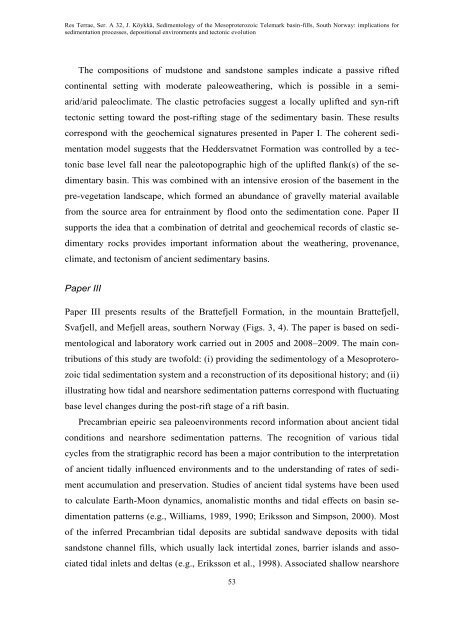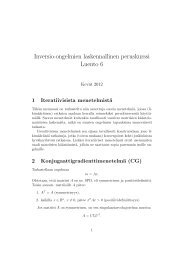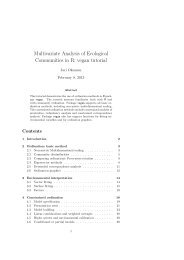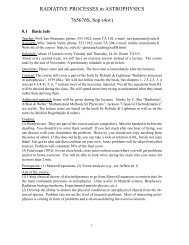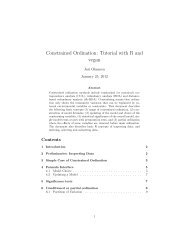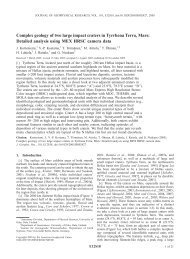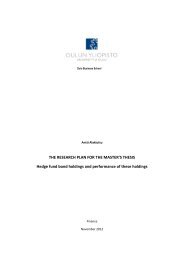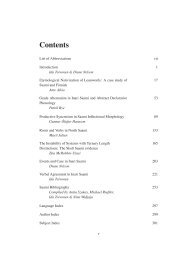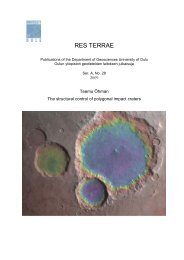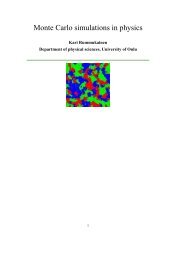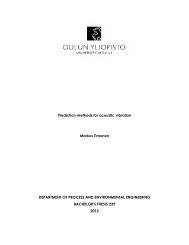Juha Köykkä - Oulu
Juha Köykkä - Oulu
Juha Köykkä - Oulu
- TAGS
- juha
- oulu
- cc.oulu.fi
You also want an ePaper? Increase the reach of your titles
YUMPU automatically turns print PDFs into web optimized ePapers that Google loves.
Res Terrae, Ser. A 32, J. <strong>Köykkä</strong>, Sedimentology of the Mesoproterozoic Telemark basin-fills, South Norway: implications for<br />
sedimentation processes, depositional environments and tectonic evolution<br />
The compositions of mudstone and sandstone samples indicate a passive rifted<br />
continental setting with moderate paleoweathering, which is possible in a semi-<br />
arid/arid paleoclimate. The clastic petrofacies suggest a locally uplifted and syn-rift<br />
tectonic setting toward the post-rifting stage of the sedimentary basin. These results<br />
correspond with the geochemical signatures presented in Paper I. The coherent sedi-<br />
mentation model suggests that the Heddersvatnet Formation was controlled by a tec-<br />
tonic base level fall near the paleotopographic high of the uplifted flank(s) of the se-<br />
dimentary basin. This was combined with an intensive erosion of the basement in the<br />
pre-vegetation landscape, which formed an abundance of gravelly material available<br />
from the source area for entrainment by flood onto the sedimentation cone. Paper II<br />
supports the idea that a combination of detrital and geochemical records of clastic se-<br />
dimentary rocks provides important information about the weathering, provenance,<br />
climate, and tectonism of ancient sedimentary basins.<br />
Paper III<br />
Paper III presents results of the Brattefjell Formation, in the mountain Brattefjell,<br />
Svafjell, and Mefjell areas, southern Norway (Figs. 3, 4). The paper is based on sedi-<br />
mentological and laboratory work carried out in 2005 and 2008–2009. The main con-<br />
tributions of this study are twofold: (i) providing the sedimentology of a Mesoprotero-<br />
zoic tidal sedimentation system and a reconstruction of its depositional history; and (ii)<br />
illustrating how tidal and nearshore sedimentation patterns correspond with fluctuating<br />
base level changes during the post-rift stage of a rift basin.<br />
Precambrian epeiric sea paleoenvironments record information about ancient tidal<br />
conditions and nearshore sedimentation patterns. The recognition of various tidal<br />
cycles from the stratigraphic record has been a major contribution to the interpretation<br />
of ancient tidally influenced environments and to the understanding of rates of sedi-<br />
ment accumulation and preservation. Studies of ancient tidal systems have been used<br />
to calculate Earth-Moon dynamics, anomalistic months and tidal effects on basin se-<br />
dimentation patterns (e.g., Williams, 1989, 1990; Eriksson and Simpson, 2000). Most<br />
of the inferred Precambrian tidal deposits are subtidal sandwave deposits with tidal<br />
sandstone channel fills, which usually lack intertidal zones, barrier islands and asso-<br />
ciated tidal inlets and deltas (e.g., Eriksson et al., 1998). Associated shallow nearshore<br />
53


